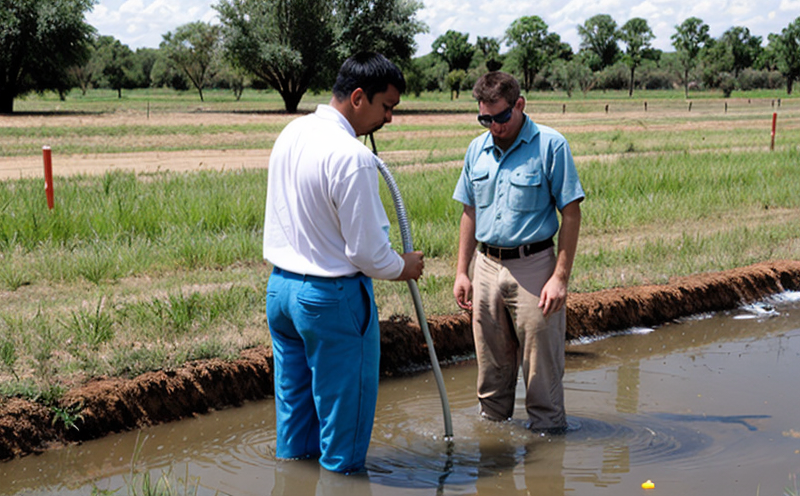ASTM D3557 Cadmium Determination Test in Groundwater
The ASTM D3557 standard method is a critical tool used to determine the concentration of cadmium in groundwater. This test is particularly important as it helps to ensure compliance with environmental regulations and protects public health by monitoring potential contamination sources.
Cadmium, though essential in small amounts for certain industrial processes and agricultural fertilizers, can be toxic at higher concentrations. Its presence in groundwater can lead to significant environmental and health risks if not properly managed. This test method provides a standardized approach to accurately measure cadmium levels, ensuring reliable data that supports informed decision-making.
The ASTM D3557 procedure involves the use of an atomic absorption spectrophotometer (AAS) for the analysis. The sample preparation typically includes dilution if necessary and filtration through a 0.45 μm filter to remove particulate matter. This step is crucial as it ensures that only the dissolved cadmium in the water is measured, providing accurate results.
The method specifies the use of a calibration curve for quantification purposes. The curve is generated using standard solutions containing known concentrations of cadmium. These standards are used to compare against the unknown sample's absorbance readings, allowing for precise concentration determination.
Interferences can occur during this process; hence, the ASTM D3557 procedure also includes steps to mitigate common interferences such as hydroxides and sulfides. By controlling these factors, the method ensures that only the cadmium in solution is measured accurately.
The significance of this test extends beyond mere compliance with regulations. It plays a key role in environmental stewardship by identifying potential hazards early on. In many regions, regulatory bodies require regular testing to ensure that groundwater quality meets safety standards set forth by international guidelines like ISO and ASTM.
Understanding the implications of cadmium contamination is crucial for stakeholders involved in water management, particularly those responsible for compliance with local, national, or international regulations. Regular monitoring using this method helps identify trends over time, allowing for proactive measures to be taken if necessary.
In summary, ASTM D3557 serves as a vital tool for ensuring the safety and quality of groundwater resources by accurately measuring cadmium levels. Its standardized approach ensures consistent results across different laboratories, which is essential for maintaining trust in environmental testing practices.
Scope and Methodology
The ASTM D3557 standard provides a comprehensive framework for determining the concentration of cadmium in groundwater samples. This method focuses on the quantification of total dissolved cadmium, which is crucial for assessing environmental impact.
- Sample Preparation: Samples are collected using appropriate containers and stored under controlled conditions to prevent contamination or degradation.
- Dilution and Filtration: Samples may need dilution if they exceed the detection limit of the analytical equipment. A 0.45 μm filter is used to remove particulate matter, ensuring that only dissolved cadmium contributes to the measured concentration.
- Analytical Procedure: The sample is analyzed using an atomic absorption spectrophotometer (AAS), which measures the absorbance of light at specific wavelengths characteristic of cadmium ions. A calibration curve generated from standard solutions helps in quantifying the unknown sample's concentration accurately.
The ASTM D3557 method is designed to be robust against interferences, such as hydroxides and sulfides, which could otherwise distort the results if not properly addressed during preparation. By following these steps meticulously, laboratories can ensure that their findings are reliable and actionable.
Benefits
The ASTM D3557 method offers several advantages for environmental testing laboratories:
- Compliance Assurance: Regularly monitoring cadmium levels helps organizations meet stringent regulatory requirements, thereby avoiding penalties and maintaining a positive public image.
- Risk Mitigation: Early detection of contamination allows for timely interventions, reducing the risk to ecosystems and human health.
- Data Accuracy: The standardized approach ensures consistent results across different testing facilities, enhancing confidence in the data produced.
- Proactive Management: Continuous monitoring enables proactive management of water resources, leading to sustainable practices that support long-term planning and strategy development.
By leveraging ASTM D3557, laboratories can contribute significantly to environmental protection efforts, ensuring that groundwater remains safe for consumption and use. This method fosters trust among stakeholders by providing transparent, reliable data that informs critical decisions regarding water quality management.
Competitive Advantage and Market Impact
- Precision and Reliability: By adhering strictly to ASTM D3557, laboratories can offer highly precise and reliable results, which are essential in competitive markets where accuracy matters.
- Regulatory Compliance: Demonstrating compliance with this standard sets a benchmark that clients expect from leading laboratories, giving these labs an edge over competitors who may not adhere to such rigorous standards.
- Customer Trust: The ability to provide consistent and accurate results builds long-term relationships with clients, enhancing brand reputation and customer loyalty.
The market for environmental testing services is competitive, but those offering ASTM D3557-compliant testing stand out due to their commitment to quality. This approach not only enhances the laboratory's standing within its industry but also supports broader efforts towards sustainable development and environmental protection.





